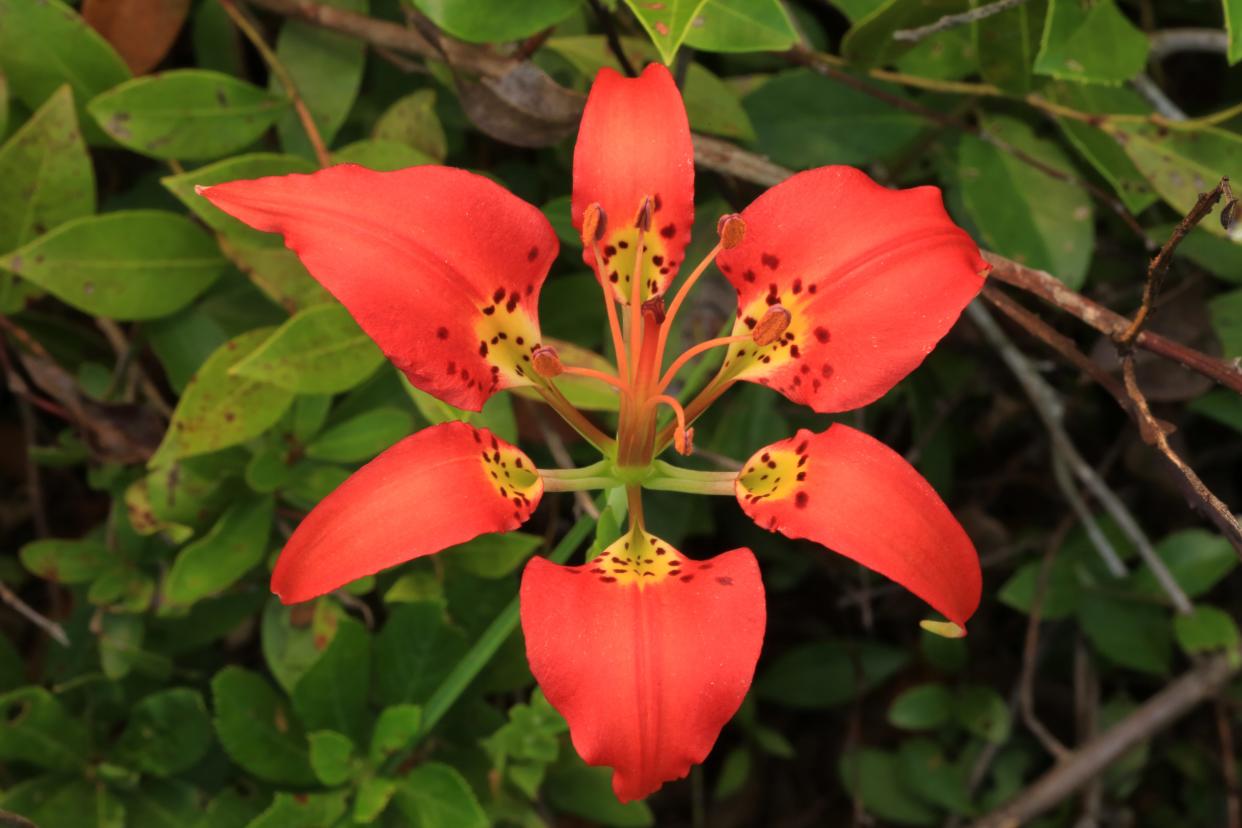South Carolina botanist named this brilliant lily in 1788 | Mystery Plant

It’s not often that we botanists, on our field trips, have to stop, speechless, and stare at a flower with jaws agape. It happened to me and my buddies recently deep in the pinelands of the Francis Marion National Forest here in my state.
Pine lily, Lilium catesbaei is not a tall plant, only about two feet high, and it never branches. A single flower is produced on each stem. The leaves are skinny and sharp-pointed, and they get progressively smaller up the stem.
Grape Harvest Festival: FAMU returns to tradition with 20th annual Grape Harvest Festival
Mystery Plant: Make hummingbirds happy: Showy plant a close relative of beloved petunia| Mystery Plant
For the birds: Skip the bird feeder hassles, plant a native tree and feed multitudes
Notice that there are six brightly colored perianth parts: the 3 sepals and 3 petals are all bright orange, and heavily spotted. They look pretty much the same, and it would be OK if we refer to them as “tepals,” just for convenience.
These tepals offer a good example of what we call a “claw”— the base of the each one is much more slender than the rest. And, these tepals generally have bright yellow coloration, along with a scattering of conspicuous purplish-brown spots.
In each flower are six stamens, as well, and a central style arising between the stamens, coming up from the ovary. If you look closely at an open flower, you are likely to see the pollen dusting the sticky stigma at the style’s tip.
If you recall your Botany 101 class (you did take botany, didn’t you?), you’ll know that plants such as this one — with grass-like, narrow leaves, and with flower parts in 3’s (or multiples of 3) — are most often classified as what we call “monocots,” as opposed to the “dicots.”
In 1788, this plant was formally named and described by a South Carolina botanist named Thomas Walter, who named the plant, then new to science, after the fascinating and much-esteemed natural historian, Mark Catesby. Walter’s book was called “Flora Caroliniana,” published in London, just five years after the end of the American Revolutionary war.
In this book, Walter attempted to describe every plant growing in South Carolina, as best he could, along with previously unnamed ones that he proposed as “new.” It would be difficult to claim that Walter was the very first European-American to ever have seen our Mystery Plant in the wild.
Imagine, though, the excitement that he must have felt upon first seeing this gorgeous flower, realizing that it had no scientific name, and the excitement and pride he must have felt when naming it after Catesby!
Walter, who lived not far from the Santee River near present-day Lake Marion, surely saw this new plant in the longleaf pine savannas and flatwoods which were so common in the region 200 years ago. Of course, most of the savannas and flatwoods have been severely altered by fire suppression or even destroyed since then.
Our mystery plant, though, is still with us today, although not as commonly. It occurs sparingly from coastal Virginia down into the Carolinas, and is probably more abundant in northern Florida, and then west to Louisiana.
Ecologically, it is probably dependent on occasional forest fires as a natural control of competing shrubby vegetation — which accounts, at least in part, for its increasing rarity.

John Nelson is the retired curator of the A. C. Moore Herbarium at the University of South Carolina in Columbia SC. As a public service, the Herbarium offers free plant identifications. For more information, visit www.herbarium.org or email johnbnelson@sc.rr.com.
Never miss a story: Subscribe to the Tallahassee Democrat using the link at the top of the page.
This article originally appeared on Tallahassee Democrat: Pine lily makes brilliant display in pinelands in Carolinas, Florida

